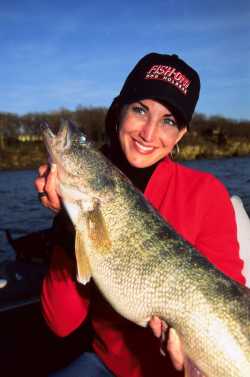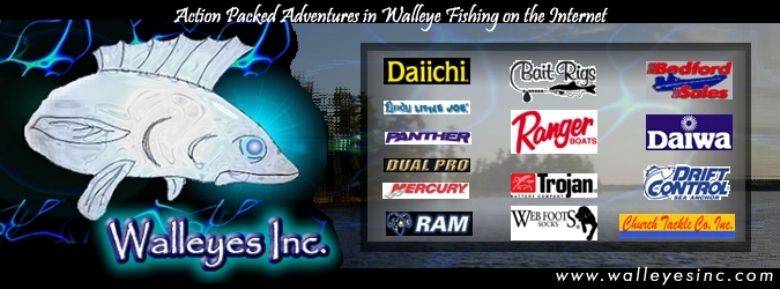|
As predator fish begin their fall feeding habits, their
focus centers on large forage. Young of the year perch, cisco,
river shiners and chubs, along with other forage, such as
frogs, crawfish and even their own off-spring will be targeted.
Successful trophy hunters will match the hatch, almost scientifically,
at this time of year. Imitation of the forage base is very
critical and a key to productivity during the summer feeding
binge! Feeding forays are anything but mysterious! The fish
have to eat a lot as summer activity increases. The perdition
cycle is in high gear on reefs, large points and adjacent
flats, and in neck down flowage areas. Veteran anglers can
predict these movements, and position themselves for hot late
summer or early fall action on the biggest fish of the year.
Walleyes are a structure oriented fish, most of the time.
You might find large schools on some Great Lakes that don't
relate to specific structure, but by and large they seek out
structure. These walleyes will be tight to the bottom, lying
in the holes between rocks and cuts in the bottom. They may
be feeding, or waiting in ambush to find an easy meal that
comes their way. When fishing structure, you have to be able
to stay tight to the structure or your lure presentation will
not be in the strike zone of the fish. Move just a boat length
away and you will be out of luck
 |
Fish tend to locate along transitional zones. The bottom
may change from sand to rock or from mud to weeds; a drop-off
may occur or slope into deep water; or water in one sector
may be a slightly different color. The most important
transition zones are the weeds. The weeds or vegetation
may be the key to successful angling. Fish are wary. This
helps them survive and can also make them difficult to
catch. They utilize their excellent senses of vision and
hearing, detect motion with unerring accuracy using their
lateral line, and also use their sense of smell. Therefore,
a cautious approach is required of an angler. With either
natural bait or artificial lures, the presentation must
be realistic. It should appear that the offering is part
of the normal food chain. Hunger is certainly a major
motivating factor, but fish also respond as predators
and strike something that moves. At times, they even exhibit
antagonistic behavior when biting an intruder to drive
it away. Walleyes love live bait, especially in the fall,
and there's no more practical way to present live bait
than behind a slip sinker slowly dragged along the bottom.
|
Rigging allows an angler to comb a lot of water quickly.
It's a great way to search for walleye schools that are scattered
along a drop-off. The key to live-bait rigging is a slow,
meticulous presentation. Terminal tackle for a live bait rig
usually includes a walking sinker threaded onto the line on
top of a barrel swivel. Keep the sinker weight as light as
possible, yet heavy enough to let you feel the weight along
the bottom. Usually 1/4 to 1/2-ounce sinkers should be adequate
for early-season fishing. From the opposite end of the swivel
I run a 2 to 4 foot snell of 6 to 8 pound test monofilament.
Adjust the distance of your live-bait rig from the bottom
according to water clarity. In stained water the fish will
be tight to the bottom so the rig should run closer to the
bottom. Just the opposite frequently holds true in clear water.
I prefer to use the Lindy Rig in this case because it allows
me the versatility of getting the live bait right in the face
of suspended walleyes. A plain hook or the colored hooks are
great, usually number 6 or number 8 finishes off the rig except
for the bait. Let the fish show you, which form of live bait
to use. A general rule is to use smaller minnows in the spring
and larger minnows in the fall, with leeches and nightcrawlers
being most productive in the warmer months of summer. However,
I've found that walleyes don't always adhere to the rules.
I like to have a complete selection of bait in the boat with
me whenever I go fishing. I've had plenty of experiences that
saw mid-summer walleyes attacking minnows and early spring
walleyes showing a preference to crawlers. Walleyes often
take minnows lightly, and will sometimes nibble at the tail
of the night crawler like a small perch does. These slow biters
have to be given time to get the bait into their mouths so
that the hook can do itís job. That's the reason for the Lindy
slip sinker, it allows you to feed line to the fish. Most
anglers use open-face Shimano spinning reels for live bait
rigging. They backtroll, with the bail open and the line caught
under the index finger of their rod hand. When they feel a
bite, they simultaneously point the rod tip back toward the
fish and straighten their finger, allowing line to run freely
off the spool. After anywhere from 3 to 30 seconds depending
on how aggressive the fish are, reel up the slack line quickly
until they feel the weight of the fish. They then snap the
rod back with authority and hoist another walleye into the
boat. This is the time of the year walleyes are feeding up
for the winter months. All you have to do is be on the water
when they decide to feed and you will get some trophy walleyes.
For more techniques on fall walleye fishing drop me a line
at www.walleye.info.
Hope to hear from you soon
|

